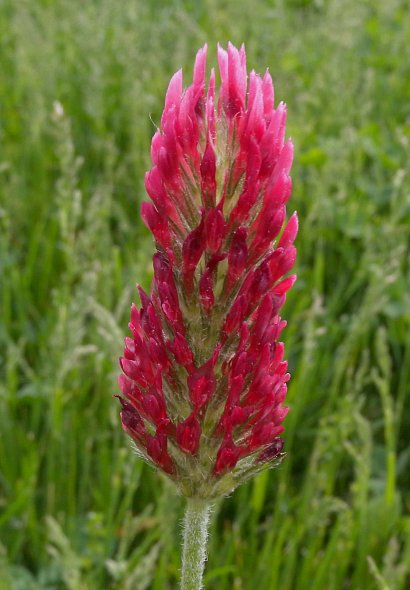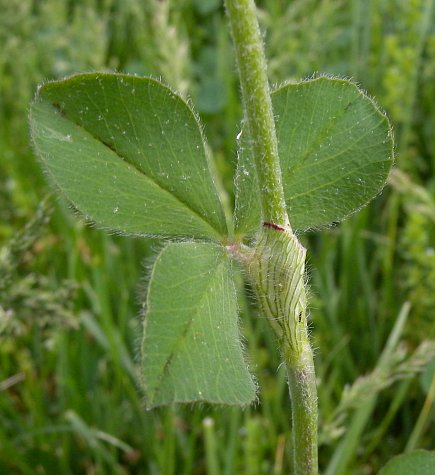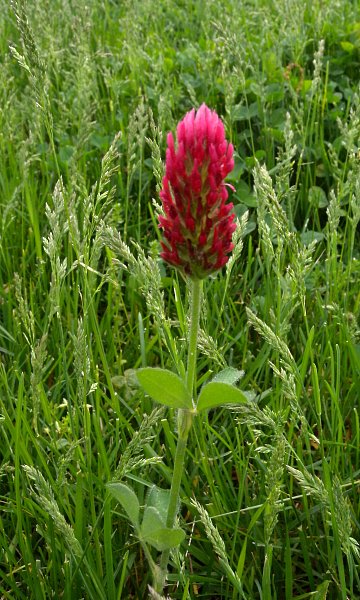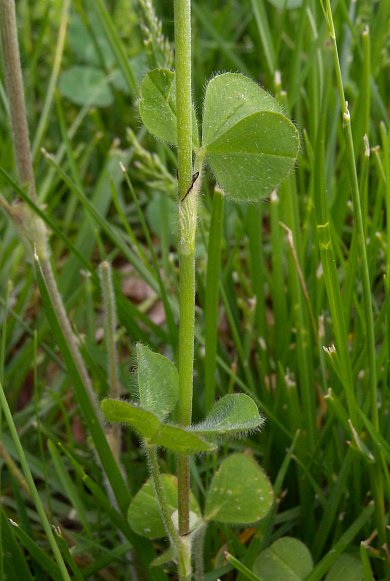
The central and any lateral stems terminate in solitary flowerheads about 1–2½" long and ½–¾" across; these flowerheads are cylindrical-ovoid in shape. The flowers are densely arranged all around each flowerhead and they are ascending in their orientation. Each narrow flower is about ½" long, consisting of a reddish corolla with 5 petals, light green to reddish brown calyx, and the reproductive organs. The corolla consists of an upper horizontal hood and a pair of lateral wings that enclose an inner keel. The hood is elliptic-oblanceolate in shape and longer than the wings; the latter are elliptic-oblong in shape. The hairy calyx is short-tubular with 5 long slender teeth; it is shorter than the corolla. The blooming period occurs from late spring into the summer, lasting 1-2 months. Afterwards, the flowers are replaced by small seedpods (about 4 mm. in length) that are ovoid in shape and slightly flattened; there are slender beaks at their tips. Each seedpod contains a single seed. The seeds are about 2.5 mm. long, ovoid in shape, slightly flattened, and pale yellow, orange-yellow, or brown. The root system consists of a slender taproot with lateral fibrous roots. This plant reproduces by reseeding itself.

Cultivation: The preference is full sun, mesic to dry-mesic conditions, and fertile soil containing loam or clay-loam; sandy soil is also tolerated, although growth will be stunted if there is insufficient potassium and phosphorus. The soil pH can vary from 5.5–7.0. This clover can successfully overwinter as far north as Zone 6. In areas further north, it can be successfully cultivated as a summer annual (Young-Mathews, 2013). Like other clovers (Trifolium spp.), this species fixes nitrogen into the soil using rhizobial bacteria.
Range & Habitat: As a naturalized plant, Crimson Clover is uncommon in Illinois, especially in the central and northern areas of the state (see Distribution Map). It was introduced into North America from Europe as a source of forage, hay, and green manure. It is cultivated primarily in SE United States for these purposes. The habitat of naturalized plants include cropland, fallow fields, roadsides, and lawns, where they normally do not persist for long (at least in Illinois). Disturbed habitats are preferred.

Faunal Associations: The flowers are cross-pollinated primarily by long-tongued bees, including the honeybee and bumblebees. Insects that feed destructively on Crimson Clover include the Bean Leaf Beetle (Cerotoma trifurcata), seed-eating broad-headed bugs (Alydus eurinus, Alydus pilosulus), the Clover Head Weevil (Hypera meles) and Lesser Clover Weevil (Hypera nigrirostris), larvae of the Fall Armyworm (Spodoptera frugiperda) and Yellow-striped Armyworm (Spodoptera ornithogalli), and larvae of a leaf-miner fly (Liriomya trifoliearum). In addition to these species, other insects that are known to feed on clovers (Trifolium spp.) include other weevils (Sitona spp.), larvae of the Clover Stem Borer (Languria mozardi), larvae of gall flies (Dasineura spp.), various plant bugs, various stink bugs, the Meadow Spittlebug (Philaenus spumarius), aphids (Nearctaphis spp., Therioaphis spp.), the Clover Root Mealybug (Chnaurococcus trifolii) and other mealybugs, the Clover Leafhopper (Aceratagalla sanguinolenta) and other leafhoppers, the larvae of Hypena scabra (Green Cloverworm) and other moths, the Eastern Tailed Blue (Everes comyntas) and other butterflies, the Red-legged Grasshopper (Melanoplus femurrubrum) and other grasshoppers, and various thrips; see Clark et al. (2004), Spencer & Steyskal (1986), Schaefer (1980), Young-Mathews (2013), Majka et al. (2007), Marshall (2006), Felt (1917), Aldrich & Osten-Sacken (1905), Watson (1928), Rider (2009), Milne & Milne (1980), Blackman & Eastop (2013), ScaleNet (2014), DeLong (1948), Covell (1984/2005), Bouseman & Sternburg (2001), Brust et al. (2008), and Vance (1974). Among vertebrate animals, the seeds of clover species are eaten by such birds as the Ruffed Grouse, Ring-necked Pheasant, Wild Turkey, Mourning Dove, Horned Lark, Smith Longspur, and Chipping Sparrow; the upland gamebirds also feed on the foliage. Some mammals also feed on these plants. The White-tailed Deer, Cottontail Rabbit, and Groundhog feed on the foliage, as do various grazing farm animals, including horses, cattle, sheep, and goats. Small rodents also feed on either the seeds and/or foliage to a minor extent; this includes such species as the Prairie Vole, Meadow Vole, and Woodland Vole (Martin et al., 1951/1961; DeVore et al., 2004; Lewis, 1993; Cole & Batzli, 1979).

Photographic Location: A lawn at Crystal Lake Park in Urbana, Illinois.
Comments: The bright red flowerheads of this clover make it easy to identify. Unlike White Clover (Trifolium repens), the leaflets of Crimson Clover (Trifolium incarnatum) are more obovate than obcordate and they lack chevrons. Another species, Red Clover (Trifolium pratense), has pink flowerheads that are more globoid in shape. All of these species were introduced from Europe into North America for agricultural purposes. In addition, the flowerheads of Crimson Clover can be used by honeybees as a source of honey. Other common names of this clover include Scarlet Clover and Italian Clover.